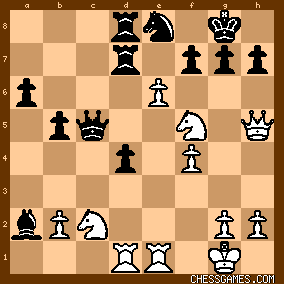KEG: Post II
With 16. Nc2, the preliminaries were over and the game became very sharp as Rosen tried to swamp Tchigorin with a King-side attack. 16... Rfd8
17. Bg5
The assault begins. This may not be the soundest approach, but it sets the tone for what is to follow. 17... d5?!
This gives Rosen--who was getting overextended--the chance he was seeking. Best was 17...h6 with perhaps g5 and d5 to follow. 18. e5!
Rosen seizes his opportunity and goes for the gold. The position is now hard to evaluate. As subsequent play reveals, both sides have chances. I would always bet on the stronger player in a double-edged position such as this one. 18... Ne8
19. Qd2
Looking for too much. 19. BxB first was soundest. 19... Ra7?!
Most players would doubtless try to defang White here with 19...BxB immediately,but Tchigorin always relished a complex tactical battle of ideas. As usual, he comes out on top here. I wonder whether Tchigorin would have made this move against Lasker. 20. Rad1 BxB
21. QxB Qe7
The position was now:

click for larger view22. Qh5?
This is the first move in this game that I would classify as a definite "mistake." White could have maintained a small advantage with 22. QxQ. With the text, Black has all the chances. 22... Rad7
All of a sudden, Tchigorin's creative 19...Ra7 looks better and better. 22...d4 was another strong move Tchigorin could have played here and if 23. cxd4 Rad7! 23. f4?!
In for a penny in for a pound. 23. Ng3 or 23. Nd2 were "better," but Rosen by this stage had obviously decided on a do-or die attack, and was not about to "waste" time bringing more of his troops into the fray. 23... d4!
This counter-attack was the best way to punish Rosen's presumptuous play. The position was now: 
click for larger view24. Ng3?
This pawn sacrifice was either excellent (as Rosenthal in the Tournament Book seemed to think) or a blunder. Analysis suggests the latter. Rosenthal is correct that 24. a3? would have lost to 24...Bb3 25. Rd2 (25. Rc1 would have been less catastrophic that Rosenthal's 25. Rd2 but would not have saved White after 25...d3) dxc3. Rosen's best chance here would have been to admit he had erred and play 24. Ra1 or tried 24. cxd4. The text should have led to defeat. 24... Bxa2?!
Too eager to snatch a pawn. White's game is already bad and could have been swamped with 24...dxc3 25. bxc3 RxR 26. RxR g6 27. Qf3 RxR+ 28. RxR and then 28...Bxa2. With the hasty text, Rosen gets some fuel for his attack. 25. cxd4
Rosenthal is correct that 25. Nf5 would give Black the better game after 25...Qf8 26. cxd4 Bb3 27. Rd2 BxN (even better would be 27...cxd4) 28. RxB cxd4. But the text--though keeping Rosen in the hunt--is not much better with best play. 25... cxd4?
A surprisingly wimpy move by Tchigorin, who I would have expected to have played 25...Bb3 or 25...g6. 26. Nf5 Qc5
26...Qe6 was better, but in any case Rosen would have compensation for the sacrificed pawn. 27. e6!
This left:

click for larger viewRosenthal in the Tournament Book described 27. e6 as "A very nice move which should win the game for White." Tchigorin, whose evaluation of the position was exactly the opposite (he thought White's attack was unsound and should lose) noted: "After this move (27. e6) the spectators considered Black's game lost." Whose evaluation was correct? As I will try to show in my next post, both sides have chances and counter-chances here, and I would rate the position as about equal. (Fritz 15 gives White a tiny edge [0.18]). In any case, the climax of the game had been reached. | 




